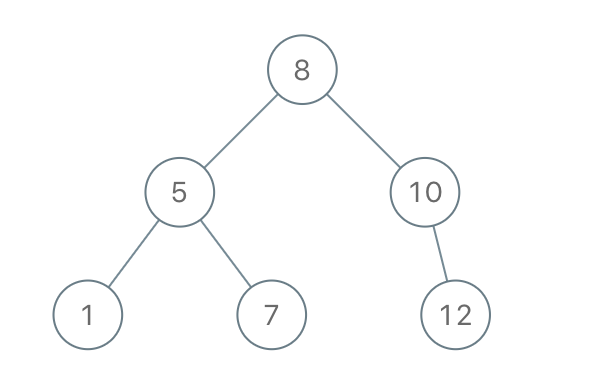- {x}
- Minimum Cost to Merge Stones
- Grid Illumination
- Find Common Characters
- Check If Word Is Valid After Substitutions
- Max Consecutive Ones III
- Maximize Sum Of Array After K Negations
- Clumsy Factorial
- Minimum Domino Rotations For Equal Row
- Construct Binary Search Tree from Preorder Traversal
- Complement of Base 10 Integer
- Pairs of Songs With Total Durations Divisible by 60
- Capacity To Ship Packages Within D Days
- Numbers With Repeated Digits
- Partition Array Into Three Parts With Equal Sum
- Best Sightseeing Pair
- Smallest Integer Divisible by K
- Binary String With Substrings Representing 1 To N
- Read More...

Construct Binary Search Tree from Preorder Traversal
Given an array of integers preorder, which represents the preorder traversal of a BST (i.e., binary search tree), construct the tree and return its root.
It is guaranteed that there is always possible to find a binary search tree with the given requirements for the given test cases.
A binary search tree is a binary tree where for every node, any descendant of Node.left has a value strictly less than Node.val, and any descendant of Node.right has a value strictly greater than Node.val.
A preorder traversal of a binary tree displays the value of the node first, then traverses Node.left, then traverses Node.right.
Example 1:

Input: preorder = [8,5,1,7,10,12] Output: [8,5,10,1,7,null,12]
Example 2:
Input: preorder = [1,3] Output: [1,null,3]
Constraints:
1 <= preorder.length <= 1001 <= preorder[i] <= 1000- All the values of
preorderare unique.
1008. Construct Binary Search Tree from Preorder Traversal
Problem Description
Given an array of integers preorder, representing the preorder traversal of a Binary Search Tree (BST), construct the BST and return its root. A BST is a binary tree where for every node, any descendant of Node.left has a value strictly less than Node.val, and any descendant of Node.right has a value strictly greater than Node.val. A preorder traversal visits a node before its left and right subtrees.
Solution: Recursive Depth-First Search (DFS)
The most efficient approach leverages the properties of preorder traversal and BSTs. Preorder traversal gives us the root node first. Since it's a BST, all nodes in the left subtree must be less than the root, and all nodes in the right subtree must be greater. This allows us to recursively build the tree.
Algorithm:
-
Base Case: If the input array is empty or the start index
iexceeds the end indexj, returnnull(representing an empty subtree). -
Create Root: Create a new tree node with the value at
preorder[i](the root). -
Partition: Find the index
kwhere the values inpreorderswitch from being less than or equal to the root's value to being greater than the root's value. This indexkseparates the left and right subtrees. We can efficiently do this using binary search. -
Recursive Calls: Recursively call the function to build the left subtree (
preorder[i+1...k-1]) and the right subtree (preorder[k...j]). -
Return Root: Return the newly constructed root node.
Time Complexity: O(n log n) - The binary search within the partition step takes O(log n) time in each recursive call, leading to a total time complexity of O(n log n). (Note: A slightly optimized approach using iterative partition would reduce this to O(n) in the average case.)
Space Complexity: O(n) - In the worst case (a skewed tree), the recursion depth can be O(n), leading to O(n) space complexity due to the call stack.
Code Implementation (Python)
class TreeNode:
def __init__(self, val=0, left=None, right=None):
self.val = val
self.left = left
self.right = right
class Solution:
def bstFromPreorder(self, preorder: list[int]) -> TreeNode:
def build(i, j):
if i > j:
return None
root = TreeNode(preorder[i])
k = i + 1
while k <= j and preorder[k] <= preorder[i]:
k += 1
root.left = build(i + 1, k - 1)
root.right = build(k, j)
return root
return build(0, len(preorder) - 1)This Python code directly implements the algorithm described above. The build function recursively constructs the tree, using binary search implicitly in the while loop to find the partitioning point k.
Code Implementation (Java)
class TreeNode {
int val;
TreeNode left;
TreeNode right;
TreeNode() {}
TreeNode(int val) { this.val = val; }
TreeNode(int val, TreeNode left, TreeNode right) {
this.val = val;
this.left = left;
this.right = right;
}
}
class Solution {
private int[] preorder;
public TreeNode bstFromPreorder(int[] preorder) {
this.preorder = preorder;
return build(0, preorder.length - 1);
}
private TreeNode build(int i, int j) {
if (i > j) return null;
TreeNode root = new TreeNode(preorder[i]);
int k = i + 1;
while (k <= j && preorder[k] <= preorder[i]) k++;
root.left = build(i + 1, k - 1);
root.right = build(k, j);
return root;
}
}The Java code mirrors the Python solution's structure and logic.
Other languages (C++, JavaScript, Go, etc.) can implement the same algorithm with minor syntactic differences. The core recursive approach and binary search based partition remain the same.